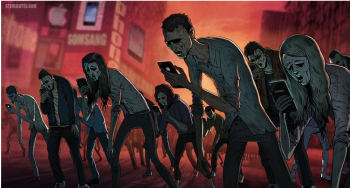CommentsWELLNESS - This is the story of a group of citizens' advocating for major change with one of the largest governmental bodies in the State of California.
That governmental body is the Los Angeles County Board of Supervisors. The effort reported here is taking place during the single most dangerous health crisis in the history of this nation. This effort to save the lives of a very vulnerable population, was done as we face the dangers and pain of Covid-19. The Board of Supervisors is a five-member board each representing 2 million voters in each of their districts.
I am an organizer with a national organization known as Social Security Works. My assignment as well as my job, is to fight for the protection and expansion of Social Security, Medicare, and Medicaid. I cover the entire state. In addition, and during the pandemic, my work has expanded here in Los Angeles. That expansion is to help older Californians get the services and help they need to stay alive during this terrible moment of Covid-19.
This effort started in early 2020 with a phone call from an old friend. That friend resides in a section 8, 61 unit building in Santa Monica. His building is called Barnard Way Apartments. His name is Shawn Casey O'Brien and his call to me was to ask that I join him on a series of phone calls with his County Supervisors’ office. The "ask" was that the supervisors' office work with the Department of Health to send medical staff to Barnard Way to test the residents of the building for Covid-19. Sadly, one of the residents in the building had recently died from Covid-19.
I have known Shawn since the late 1970's. He is one of the best community organizers I have ever known. Through the years, I have seen him organize statewide to increase voter participation for the disabled community all over California. For years Shawn had his own radio show featuring experts and political leaders that cared about issues facing the poor, people with disabilities and seniors. His book, "For the Love of Long shots, A memoir on Democracy" chronicles his organizing work in fighting against discrimination of disabled citizens. He mixes smart guidance on how to organize with talk about the need to organize during each and every election, disabled voters to have a strong presence with elected officials. He founded the Unique People's Voting Project which led a very effective registration drive in California.
After two long phone calls, the supervisor’s office said no to our requests that Covid-19 testing take place at Barnard Way. The supervisor staffer was sympathetic while stating that such a service was readily available elsewhere. So, we did what organizers do and decided to bring people together and organize. At the time, we were aware of the awful circumstance in nursing homes. Hundreds and then thousands of nursing home residents and staff serving those residences were dying because of Covid-19.
As we made our next move, we said to ourselves that we did not want to see the same circumstance take place in senior apartment buildings. Hence, we started contacting friends and other activists. Within a month the "Coalition for mobile in-home testing and vaccinations was formed." We organized folks so that each supervisor's district would have a working committee put pressure on the County to start in home testing and, later, vaccinations.
Talking points were fashioned so that each of the five groups were presenting a unified voice to the offices of each of the five members of the Board of Supervisors. After the necessary materials and facts were gathered, our teams started making calls, asking for a meeting with each of the Supervisors. In every case, our teams were only able to meet with staffers.
We relied heavily on demographic information as well as a report issued in 2018 known as "Purposeful Aging Los Angeles." From that study and from our own knowledge of the community we made the following points:
* 24% of all seniors no longer drive
* Just under 40% depend on public transit.
* For frail and older residents, it made sense to offer a homebound program.
* Poverty rates in Los Angeles are high for seniors.13.12% of seniors in Los Angeles County live at or below the poverty line. Add to this factor the fear and danger of Covid-19 and low-income seniors obviously need extra help.
All the above lead to our conclusions that those that are homebound, due to their health, due to Covid-19 dangers of being away from home and finally they could not afford the cost of transit... we knew that advocating for a homebound program made sense and would save lives.
We lobbied hard with these and other facts. Our request was that the County start doing an in-home testing and vaccination program for those seniors that were homebound.
Finally, on March 23rd, 2021, the County Board of Supervisors voted to start a homebound program for the "often forgotten homebound seniors and people with disabilities". It identified 220,000 homebound residents from the In-Home Supportive Services program in Los Angeles County along with 55,000 from home delivered meals on wheels.
It turned out that the hard part of this was just beginning. From the month that the homebound program began we started asking for reports on the number of people visited via the program. We also requested to see a media plan, their plan to communicate with other governmental bodies and what kind of budget the County was working with.
On those counts, we heard an array of numbers. 2,000, 4000, 5,000, 10,000. We were never given the media plan (we thus assumed they had none). Staffers did tell us that they had communicated this program out to offices of elected officials yet we were never given the literature they were providing. As far as the dollars spent .... County officials ignored us.
But the most glaring and shocking memo received from the County of Los Angeles Department of Public Health arrived by email in mid-October of this year.
Entitled "Los Angeles County Department of Public Health, Homebound Covid-19 Vaccination Summary and Data Report" the report said the following:
* It ignored the Solis estimate of the number of homebound and came up with "10,000 - 15,000" people that are homebound. However, the reported committed to providing home vaccination services "as long as there is a need." One has to ask if they reach 15,000 vaccinations, is the program over? And, what about the Solis estimates which were, again, 220,000 from In Home Supportive Services and 55,000 meals on wheels?
* Under the section called "Approach" the reported that DPH (Department of Public Health) is part of a larger network of organizations providing vaccinations to homebound individuals in LA County." Those programs local fired departments, nonprofit organizations, mobile vaccine providers, long term care facilities, home delivered meals and more.
* The most troublesome section of this report is in the section called "Data Limitations." Here is the opening language for this section: "The data presented in this report are limited to vaccinations provided through the DPH homebound vaccination program (that number is 2,315). No data are available on the many vaccinations provided to homebound individuals by providers not in the DPH homebound program." This section goes on to say that "More complete reporting is difficult to achieve, given that reporting is voluntary and program partners have many competing demands." So, when Meals on Wheels or Adult Day Health Care and or other partners has arranged to get the vaccination for their members, the county is not being told how many people have received the vaccination. Without that data, how is the County making sure that follow up is happening. The second shot or the booster..... lack of specific data to the locations makes the follow-up impossible. This section is a glaring admission that there will not be any kind of accountability for how effective this program is.
Another alarming part of this had to do with how our organizations was treated. In good faith we asked questions about how many people had been vaccinated via the homebound program. It turns out that due to the most recent report no count has really been taken. In answer to the question how much County, State and Federal dollars had been allocated and then spend... we were ignored.
Bottom line, the County needs to collect the information that will guide them in assuring that every single homebound resident has been vaccinated. Instead, due to the failure to require reporting, the public, health officials and the homebound themselves cannot assess what is working or not working.
To say it is not possible to gather this information is simply wrong and irresponsible. One phone call a day to a centralized call in number by the providers that report on the number of vaccinations done and where they took place is logistically possible and easy.
My own experience is relevant. In every legislative effort and or campaign I have either lead or been part of I had to report numbers and or results to a central manager. How many consumers did I turn away at the local Safeway during the grape strike for the farm workers? How many votes did my candidate win in taking on the incumbent? The point is that numbers mean something, especially when a nation is fighting a deadly virus.
Moving forward, our next step in our effort is to meet with every member of the County Board of Supervisors and alert them to this issue. We will make it clear that that County Health must set up a system that reports on the matters reported here. Further, from the date of the original resolution was voted on and passed (March 23 of 2021) to have only vaccinated 2,315 home bound residents is just not acceptable.
We still have the same requests:
* Number of Homebound vaccinations done and publicly reported on every two weeks.
* A media plan that tells the public how to get the shots at home if a person is homebound
* Coordination and marketing with every elected official in Los Angeles County
* An accounting of dollars spent and dollars to be spent.
* The county of Los Angeles Department of Public Health must deploy teams quailed to give vaccinations such that a higher number of inoculations takes place. This needs to take place along with the partners that are engaged.
We are still in the Covid-19 crisis. And, given that there are nearly two million residents over the age of 60 in Los Angeles County, a very organized and aggressive effort is called for. It is about defeating this terrible virus. It is about saving lives.
All must join and make this work.
(Ernie Powell is a Koreatown resident, who works for the national organization, Social Security Works. Our mission is to protect and expand Social Security, Medicare and Medicaid. Before that Ernie was with AARP for 19 years as a field organizer and also a California Manager of Advocacy. He is trained in Direct Action Organizing and currently is a co-founder for the California Institute for Organizing and Policy. Ernie is a contributing writer for CityWatch.)
























